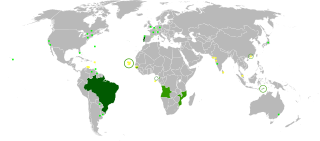
Braga is a city and a municipality in the northwestern Portuguese district of Braga, in the historical and cultural Minho Province. The city has a resident population of 192,494 inhabitants, representing the seventh largest municipality in Portugal. Its area is 183.40 km². Its agglomerated urban area extends from the Cávado River to the Este River. It is the third-largest urban centre in Portugal

Alandroal is a municipality in the Portuguese district of Évora located on the eastern frontier with Spain along the right margin of the Guadiana River in the Central Alentejo region. It is located 341 metres (1,119 ft) above sea level, northeast of Évora and southeast of Estremoz. The population in 2011 was 5,843, in an area of 542.68 km².

Arcas is a Portuguese civil parish in the municipality of Macedo de Cavaleiros in the northeast corner of Portugal. The population in 2011 was 262, in an area of 23.02 km2.

Labruja is a civil parish in the municipality of Ponte de Lima in northern Portugal. The population in 2011 was 439, in an area of 14.56 km².

Nelas is a municipality located in the Centro Region of continental Portugal. The population in 2011 was 14,037, in an area of 125.71 km².

Castle of Braga is a historical fortification and defensive line encircling the city of Braga. While, in fact, the only remains of this structure are the various gates and towers along its perimeter, the main keep tower, located in the civil parish of São João do Souto, is the only true remnant of the medieval castle.
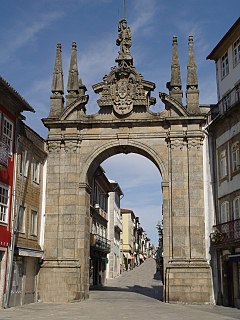
The Arch of the New Gate, is a Baroque and Neoclassical arch, designed by André Soares in the late 18th century, in the civil parish of Sé, municipality of Braga, in northern Portugal. The triumphal arch which decorates the western entrance to the medieval wall of the city, was opened in 1512 and traditionally used to present the city's keys to dignitaries and celebrities.
The Tower of Penegate, is a 3-storey quadrilateral tower, located in the civil parish of São Miguel de Carreiras in municipality of Vila Verde, in the northern region of Portugal.
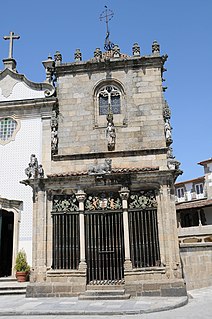
The Chapel of the Coimbras is a Manueline chapel located in the civil parish of São João do Souto, in the municipality of Braga. It has been classified as a National Monument since 1910.

The Archiepiscopal Palace of Braga, is a Portuguese episcopal palace in civil parish of Braga, in the municipality of the same name, in the northern district of Braga.

The Garden of Santa Barbara is a municipal garden in the civil parish of Sé, municipality of Braga, alongside the eastern wing of the historical Archbishop's Palace of Braga.

The Chapel of São Frutuoso, also known as the Chapel of São Frutuoso of Montélios or the Chapel of São Salvador of Montélios, is a pre-Romanesque chapel in the civil parish of Real, municipality of Braga. It is part of group of religious buildings that include the Royal Church, and originally built by the Visigoths in the 7th century, in the form of a Greek cross. Since 1944, it has been classified as a National Monument.

The Residence of the Crivos is a Renaissance-era shop/residence constructed outside the old walls of Braga, in the civil parish of São João do Souto, municipality of Braga. It is characteristic of late Renaissance architecture and one of the few examples of a building covered in wood-lattice facade from this period.

The Bridge of Prado is a bridge constructed over the Cávado River, in the civil parish of Vila de Prado, municipality of Vila Verde, in Norte Region, Portugal northern Portugal. Although originally a Roman bridge, it was re-constructed during the 16th century when the original had been destroyed following flooding and consistent use. There are few vestiges of the Roman bridge.

The Fountain of Campo das Hortas is a fountain located in civil parish of Sé, municipality of Braga in northern Portugal.
The Castle of Vidigueira is a castle in the civil parish of Vidigueira in the municipality of Vidigueira in the Portuguese subregion of Baixo Alentejo. Although constructed in the first half of the 15th century, it is more commonly associated with the first of the Counts of Vidigueira: Vasco da Gama.
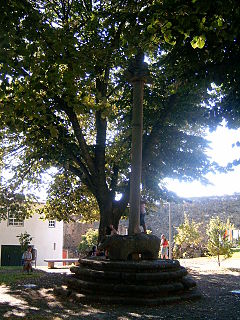
The Pillory of Bragança is a 15th-century sculpted stone column with symbolic political, administrative and judicial significance, erected over a four-step octagonal platform, located in the civil parish of Sé, Santa Maria e Meixedo, municipality of Bragança. It consists of a cylindrical column erected over a square platform, sculpted with zoomorphic symbols, anthropomorphic scenes and the shield of the city of Bragança. Its structural design and sculptural ornamentation is characteristics of the era; the column is classified as a National Monument since 1910.

The Pillory of Aguiar da Beira is a pillory located in the civil parish of Aguiar da Beira e Coruche, in the municipality of Aguiar da Beira, Portuguese district of Guarda.
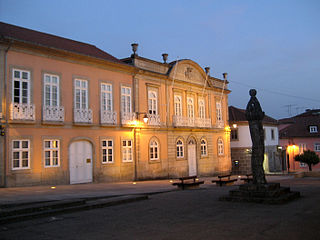
The Pillory of Arcos de Valdevez is a 15th-century sculpted stone column with symbolic political, administrative and judicial significance, located in the civil parish of Arcos de Valdevez (Salvador), Vila Fonche e Parada, municipality of Arcos de Valdevez.

The Pillory of Lisbon is a pillory situated in the municipal square of the Portuguese capital, classified as a National Monument.

